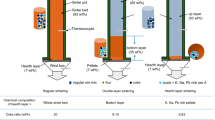Abstract
Purpose
Metal contamination arising from boat maintenance is a growing environmental concern. In this study, metals currently or historically employed in boat paints (Ba, Cu, Pb, Sn and Zn) have been determined in geosolids sampled from within and in the vicinity of two leisure boat maintenance facilities in south west England.
Materials and methods
Samples of dusts, sediments and soils from two boatyards and from various urban control sites were fractionated through 63 μm before being digested in boiling aqua regia. Metal concentrations were determined in sample digests by inductively coupled plasma spectrometry.
Results and discussion
Metal concentrations were highly variable in each medium but were greatest in boatyard dusts which, pre-fractionation, often contained visible particles of paint. Metal concentrations in sediments and soils were higher than concentrations in respective control samples and, in many cases, exceeded environmental quality standards or predicted effect concentrations. Observations are attributed to the heterogeneous contamination of geosolids by fine particulates of antifouling paint generated during boat maintenance and repair; specifically, particulates contaminate sediment via boatyard runoff (with rainfall and washdown water), while soil is contaminated through the deposition of fine, airborne paint dusts.
Conclusions
This study demonstrates that boat paint particles enriched in a variety of metals contaminate both coastal and terrestrial environments. Contamination arises from the removal and dispersion of dusts during boat maintenance. Stricter measures for the containment and disposal of wastes generated by boat repair and repainting are, therefore, recommended.

Similar content being viewed by others
References
British Marine Federation (2005) Environmental code of practise: Practical advice for marine businesses, sailing clubs and training centres. Egham, Surrey
Canadian Council of Ministers of the Environment (2012) Canadian Environmental Quality Guidelines and Summary Table: http://www.ccme.ca/ accessed March 2013
Dafforn KA, Lewis JA, Johnston EL (2011) Antifouling strategies: history and regulation, ecological impacts and mitigation. Mar Poll Bull 62:453–465
Decelis R, Vella AJ (2007) Contamination of outdoor settled dust by butyltins in Malta. Appl Organometal Chem 21:239–245
Environment Canada (2004) Information for boatyards – The Federal Fisheries Act and Hull Maintenance BMPs. Vancouver, BC
Environment Agency (2011) Chemical Standards: http://evidence.environment-agency.gov.uk/ChemicalStandards/home.aspx accessed March 2012
Jessop A, Turner A (2011) Leaching of Cu and Zn from discarded boat paint particles into tap water and rain water. Chemosphere 83:1575–1580
Links I, van der Jagt KE, Christopher Y, Lurvink M, Schinkel J, Tielemans E, van Hemmen JJ (2007) Occupational exposure during application and removal of antifouling paints. Ann Occup Hyg 51:207–218
MacDonald DD, Ingersoll CG, Berger TA (2000) Development and evaluation of consensus-based sediment quality guidelines for freshwater ecosystems. Arch Environ Contam Toxicol 39:20–31
Maharachpong N, Geater A, Chongsuvatwong V (2006) Environmental and childhood lead contamination in the proximity of boat-repair yards in southern Thailand—I: pattern and factors related to soil and household dust lead levels. Environ Res 101:294–303
Omae I (2003) Organotin antifouling paints and their alternatives. Appl Organometal Chem 17:81–105
Singh N, Turner A (2009) Trace metals in antifouling paint particles and their heterogeneous contamination of coastal sediments. Mar Poll Bull 58:559–564
Srinivasan M, Swain GW (2007) Managing the use of copper-based antifouling paints. Environ Manag 39:423–441
Thomas KV, McHugh M, Hilton M, Waldock M (2003) Increased persistence of antifouling paint biocides when associated with paint particles. Environ Poll 123:153–161
Turner A (2010) Marine pollution from antifouling paint particles. Mar Poll Bull 60:159–171
Turner A, Radford A (2010) Bioaccessibility of trace metals in boat paint particles. Ecotox Environ Safet 73:817–824
Turner A, Singh N, Richards JP (2009) Bioaccessibility of metals in soils and dusts contaminated by marine antifouling paint particles. Environ Poll 157:1526–1532
Turner A, Cabon A, Glegg GA, Fisher AS (2010) Sediment-water interactions of thallium under simulated estuarine conditions. Geochim Cosmochim Acta 74:6779–6787
Acknowledgments
Ms Corrine Riley, Mr Andrew Arnold, Mr Guy Nguendeng and Dr Andrew Fisher, UoP, are thanked for technical assistance throughout the study.
Author information
Authors and Affiliations
Corresponding author
Additional information
Responsible editor: Willie Peijnenburg
Rights and permissions
About this article
Cite this article
Turner, A. Metal contamination of soils, sediments and dusts in the vicinity of marine leisure boat maintenance facilities. J Soils Sediments 13, 1052–1056 (2013). https://doi.org/10.1007/s11368-013-0686-2
Received:
Accepted:
Published:
Issue Date:
DOI: https://doi.org/10.1007/s11368-013-0686-2




